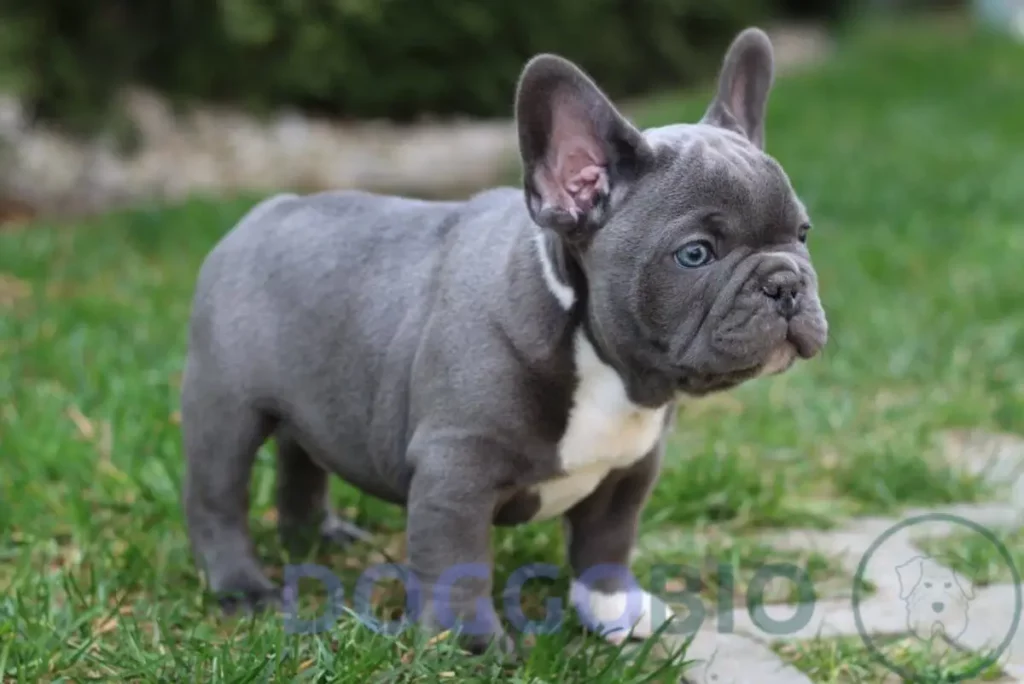The Blue French Bulldog, also known as the “Blue Frenchie,” is a charming and beloved dog breed that has captured the hearts of dog lovers worldwide. These adorable canines are known for their distinctive blue-gray coat, expressive eyes, and affectionate and loyal personalities.
Originally bred in France as a companion dog, the Blue Frenchie has become increasingly popular thanks to its unique look and delightful demeanor. Whether you are a seasoned dog owner or a first-time pet parent, the Blue French Bulldog will surely bring joy and companionship to your life.
This article will delve deeper into the history, characteristics, and care requirements of the Blue Frenchie, so you can decide if this breed is the right fit for you.
A Brief Overview of Blue French Bulldog
| Blue French Bulldog information | |
| Size | Small |
| Purity | Purebred |
| Purpose | Companion dog |
| AKC Recognition | Yes |
| Weight | 17 – 28 pounds |
| Height | 11 – 13 inches |
| Coat Colors | Gray, Light Gray |
| Temperament | Affectionate, Loyal, Playful |
| Lifespan | Short (around 9-11 years) |
| Average Puppy Cost | $4,000 upwards |
What is a Blue French Bulldog?

A Blue French Bulldog sports a unique blue-gray coat, a result of a genetic mutation that dilutes the black pigment in their fur. This change in melanin pigment gives them their distinctive hue. It’s a recessive trait, meaning both parents must carry the gene for their offspring to exhibit this color.
Beyond their eye-catching coat, Blue Frenchies are beloved for their small, muscular build and charming, wrinkly faces, making them a favorite among dog enthusiasts.
Are Blue French Bulldogs blue at all?
No, Blue French bulldogs aren’t blue at all! You heard it right. Despite the name, these adorable pups are gray-blue or silver. The blue appearance comes from diluting the black pigment in their fur, giving it a bluish tinge.
History of French Bulldog
French Bulldogs are a breed with a misleading name that may leave many scratching their heads. They didn’t come from France, as their name suggests, but rather from the Leeds area in the United Kingdom.
The breeding of this small dog breed came about to create a more friendly and less aggressive version of the English Bulldog. The English Bulldog was initially bred for bull-baiting and blood sports and later as an assistant to cattle butchers, but eventually lost its usefulness.
Breeders started crossing the English Bulldog with other dogs to save the breed to create a smaller version. The French Bulldog resulted from this crossbreeding, although this name didn’t know it. They were crossed with more miniature Terriers and other breeds to reduce the Bulldog’s size.
However, the smaller Bulldogs didn’t appeal to most Britons, except lacemakers, who adored them. But they gained little popularity beyond the lacemaking sector. When the lacemakers migrated to France seeking better opportunities, they brought their beloved dogs.
The French Bulldogs were enthusiastically welcomed in France, and their popularity skyrocketed. They quickly became associated with France rather than the UK, their country of origin.
What Does a Blue French Bulldog Look Like?
The appearance of a Blue French Bulldog is quite distinctive. Though they have the same build and physique as other French Bulldogs, the Blue Frenchie is set apart by its unique color.
A stocky, muscular body with a curved back and broad, thick neck characterizes them. Their chest is vast, and their body is rounded, with a short tail that can either be straight or curled.
The head of a Blue French Bulldog is square-shaped, with a broad and deeply set muzzle. They have round eyes set moderately apart and can come in various colors, such as brown, blue, or green. Their ears are shaped like a bat and carried upright.
The blue coat of the Blue Frenchie can vary in shades, with variations including solid blue, blue merle, blue fawn, blue pied, blue sable, and blue and tan.
These dogs also have wrinkles around their forehead and well-developed cheek muscles. Their coat is short and smooth, lying close to their body.

Size, height, and Weight
Blue Frenchies are pint-sized pups weighing 16 to 28 pounds. Males are more significant than females and can stand between 11 and 13 inches tall at the shoulder
French bulldogs may vary depending on various factors, including genetics, diet, and overall health. Nonetheless, Frenchies are commonly characterized by their sturdy, muscular build and short, stocky frame proportionate to their size.
Temperament and Personality
Regarding character, blue Frenchies are cut from the same cloth as other Frenchies.
Frenchies are generally friendly, affectionate, and playful pups who make great companions for families and singles alike.
They’re typically well-behaved around children and other pets and don’t require much exercise, making them ideal for apartment living or busy folks who can’t dedicate much time to dog walking.
Is Blue French Bulldog a good fit for families?
The Blue French Bulldog, like all dog breeds, is unique in its way, and there are a few things to consider before bringing one home to the family. One factor to remember is that they are a small breed, which can be both a positive and negative attribute.
- On the positive side, their small size means they are unlikely to cause any harm to kids or pose any significant threats. However, it also means they are not excellent watchdogs and won’t offer much protection for the household.
- In terms of temperament, these dogs are generally known for their gentleness and friendly demeanor. They love being handled and shown affection, so having a family with more people around to give them attention can be a huge plus.
- That being said, it’s important to remember that each dog has its personality and quirks. While the breed is known for being good with children, it’s always important to supervise interactions between dogs and kids to ensure both parties are safe and happy.
Overall, the Blue French Bulldog can make an excellent addition to a family home. Still, it’s crucial to research the breed and ensure it fits your lifestyle and family dynamic before bringing one home.
Training

The French Bulldog has a moderate energy level, with short bursts of excitement. They are not high-energy, so expect them only sometimes to jump around. These cute little pups require slower exercises because they can quickly get out of breath due to their squished faces.
Keep a steady pace when taking them for walks and avoid overexerting them. They only need about 30 minutes of exercise daily, so slow walks should do the trick. If you enjoy walking with your Frenchie, aim for 6 miles per week.
Exercise Requirements
The French Bulldog has a moderate energy level, with short bursts of excitement. They are not high-energy, so expect them only sometimes to jump around. These cute little pups require slower exercises because they can quickly get out of breath due to their squished faces.
Keep a steady pace when taking them for walks and avoid overexerting them. They only need about 30 minutes of exercise daily, so slow walks should do the trick. If you enjoy walking with your Frenchie, aim for 6 miles per week.
Grooming and Cleaning
Grooming your Blue French Bulldog is a quick and easy task that also serves as a bonding experience for you and your furry friend.
- Their coat is short and close to their skin, meaning they don’t shed much and only need minimal brushing about once a week. However, this breed is more susceptible to skin dermatitis, so keep an eye on their skin and hair.
- In addition to their fur, they keep their teeth clean as their brachycephalic faces make them more prone to tooth and mouth diseases.
- Trim their nails several times a month, and ensure they don’t get exposed to extreme heat or cold.
- Bathing your Blue Frenchie is not recommended, as it can exacerbate skin issues. Instead, opt for dry shampoo or wipes to keep them clean and smelling fresh.
| Grooming Needs | Grooming Frequency |
| Bathing | Once a month |
| Hair Brushing | 3 times a week |
| Teeth Brushing | 3-4 times a week |
| Coat Maintenance | Regular brushing and occasional combing |
Are Blue French Bulldogs Hypoallergenic?
No, Blue Frenchies are not hypoallergenic. Although Blue Frenchies are low shedders, they still produce dander, which can trigger allergies in sensitive individuals.
So, if you have allergies, think twice before getting a Blue Frenchie.
Food and Diet
The French Bulldog is a little dog that isn’t enthusiastic about physical activity. As a result, their hunger levels are generally low, even though they might appear always to be craving food. To keep them healthy, give them just 1-2 cups of high-quality dog food daily, with smaller kibble sizes than average.
Their smushed faces can make it difficult for them to pick up food and chew it properly, so it is better to select more comfortable kibble. To prevent potential bloating issues, divide their daily food intake into two smaller daily meals.
Common Health Issues

1. Color dilution alopecia
CDA is a genetic skin disease that causes dry, flaky, and itchy skin, hair thinning, and loss. It’s not a pretty sight, let me tell you. The onset is typically between 6 months to 2-3 years of age, and it’s more common in Blue/Lilac/Blue Fawn dogs. Sadly, there is no cure for CDA, but it can be managed with moisturizers, dietary changes, vitamin supplementation, and other methods.
The symptoms of CDA include thin hair, a dry and dull coat, hyperpigmentation, and hair loss that progressively worsens, starting as patches of hair loss. However, diagnosing CDA is challenging, requiring ruling out other issues. Unfortunately, there is currently no way to test for it as the gene responsible still needs to be discovered. So, if you’re thinking of getting a Blue Frenchie, be sure to keep these health issues in mind.
2. Eye problem
If you have a French Bulldog, you should know that they are prone to various eye problems. Cherry eye, cataracts, entropion, and distichiasis are just a few examples of eye conditions that can afflict these adorable pups.
The Cherry eye is where the tear gland pops out of position, while cataracts cause the eye’s lens to become cloudy. Entropion causes the eyelid to roll inward, and distichiasis leads to wayward eyelash growth in the wrong spot. Keep an eye out for these issues, and get your furry friend checked out by a vet if you notice anything unusual!
3. Spines Issue
Regarding their spines, they can also face some serious issues. These include hemivertebrae, a spinal deformity; intervertebral disc disease when the discs between the vertebrae degenerate or rupture—and degenerative myelopathy, a nasty progressive disease that affects the spinal cord. Stay on top of your Frenchie’s health, and watch for any signs of discomfort or mobility issues!
4. Respiratory issues
Their flat faces and short snouts make them prone to various respiratory issues. For example, they may have stenotic nares or narrow nostrils, which can make it difficult for them to breathe. Additionally, they may have an elongated soft palate, which can obstruct their airway and cause breathing difficulties.
Tracheal collapse is another respiratory issue that Frenchies may experience. This occurs when the trachea collapses or flattens, making it hard for them to breathe correctly.
5. Allergy symptoms
Frenchies, like their human counterparts, can develop allergies too! Yep, that’s right – pollen, dust, and certain foods can send their systems into overdrive. This can cause problems like itching, skin irritation, and tummy troubles.
So, if you notice your Frenchie scratching more than usual or experiencing other allergy symptoms, you must see a vet who can help you determine the best course of action.
6. Joint problems
Joint problems are no joke for Frenchies. These pups are prone to conditions like hip dysplasia, elbow dysplasia, patellar luxation, and arthritis. These can make it challenging for them to move around and can cause them some severe pain.
So, if you’re considering adopting a Frenchie, ensure you know these potential issues and take steps to prevent them!
How Long Dóe a Blue French Bulldog Live?
Blue French Bulldogs generally have a 10 to 12 years lifespan. This is subject to various factors such as genetics, diet, and overall health.
To increase the chances of a long and healthy life for your Blue Frenchie, it is recommended to provide proper veterinary care, balanced nutrition, and regular exercise. Maintaining a healthy weight is also essential since obesity can lead to various health problems such as joint issues, heart disease, and diabetes.
It’s important to remember that the lifespan of a Blue French Bulldog can be affected by its lifestyle and living conditions, as well as any health conditions or diseases it may develop.
How Much is The Price of Blue French Bulldogs?
We all know that Frenchies can be quite the investment, but when it comes to the Blue variety, be prepared to pay even more than the average Frenchie price of $3,500. Yes, you heard that right – Blue French Bulldog puppies can cost anywhere between $4,000 to a staggering $9,000.
But don’t go breaking the bank just yet, my dear reader. A good breeder will be costly, but you should still pay for a Frenchie. Remember that Frenchies, unlike most dog breeds, require artificial insemination and a c-section to give birth. For those unfamiliar with these procedures, a c-section is used to remove puppies from the uterus, while artificial insemination is used to impregnate a female dog.
All these fancy procedures come at a cost – you can expect to pay at least a couple thousand dollars for a well-bred Frenchie. Did you know that the average cost to breed a Frenchie is $7,000? So, while the price tag of a Blue Frenchie may seem steep, it’s essential to consider the cost of breeding and the unique methods required for these lovable pups.
Is Blue French Bulldog Right For Me?
Are you uncertain if the Blue French Bulldog is the perfect addition to your family? Don’t fret; take this quick quiz:
- Do you have the patience and energy to train a Blue Frenchie who may be stubborn, particularly during potty training?
- Are there kids in your household who will interact with the puppy?
- Do you have other pets at home that the Blue Frenchie will need to socialize with?
- Can you commit to providing care for the pup for the next ten years or so?
- Are you searching for a lapdog instead of a watchdog?
- Are you not allergic to pet dander?
If you answered all these questions positively, then a Blue French Bulldog may be the perfect furry friend for you!
List of dogs that are similar to Blue French Bulldog
- Blue Merle French Bulldog
- Blue Fawn French Bulldog
- Merle French Bulldog
- Isabella French Bulldog
- Piebald French Bulldog
- Platinum French Bulldog
- Sable French Bulldog
- Grey French Bulldog
- Mini French Bulldog
Frequently Asked Questions
1. Are AKC-recognized Blue Frenchies?
No, The AKC doesn’t officially recognize blue Frenchies! Nope, they are not considered a true Frenchie by the AKC, even though they are so cute!
The AKC only recognizes eight colors as official Frenchie colors, and here they are Cream French Bulldog, fawn, white, fawn & white, brindle, white & brindle, fawn brindle, and fawn brindle & white. So if you have a Blue Frenchie, the AKC may not consider it an “official” Frenchie, but it’s still a beloved and excellent companion!
2.What Makes French Bulldog Blue?
It takes two copies of the recessive gene to make a Blue Frenchie.
But don’t let their unique coat color fool you. These little guys are just as lovable and charming as their non-blue counterparts.
3. Are Blue Frenchies Rare?
Yes, Blue Frenchies are so rare! You won’t find them every day because they are one of the rarest and most coveted colors among Frenchies!
4. Are blue French bulldogs getting along with kids?
Yes, blue French bulldogs generally get along with kids. They are known for being friendly, playful, and patient, making them suitable for families with children.
However, supervision is essential during interactions to ensure safety. It’s important to teach children how to properly interact with dogs and respect their space, especially during sleep or meal times.
Keep in mind that each dog has its own personality, and factors like training, socialization, and the child’s behavior towards the dog can affect their compatibility.
5. Are Frenchies get along with other pets?
Yes, Frenchies generally get along with other pets. They are known for their amiable nature, especially if they have been properly socialized from a young age. Exposure to other dogs and cats during their early years helps them develop friendly behaviors towards other animals.
Therefore, early socialization is key to ensuring they interact well with other pets as they grow.
6. Are Blue French Bulldogs purebred?
Yes and no. A Blue French Bulldog can be purebred if both its parents are purebred French Bulldogs. However, sometimes what appears to be a Blue French Bulldog might actually be a mixed breed.
For instance, a Frenchton, a mix between a French Bulldog and a Boston Terrier, can closely resemble a purebred Frenchie. Therefore, whether a Blue French Bulldog is purebred depends on its specific breeding and lineage.
7. Do French Bulldogs shed a lot?
Yes, French Bulldogs do shed, but the amount varies. Factors influencing shedding include age, genetics, coat color, seasonal changes, and diet. Blue French Bulldogs typically shed less than their lighter-colored counterparts. The coat texture also plays a role; darker Frenchies often have smoother, silkier hair.
Shedding tends to increase during seasonal transitions, particularly in spring and fall. However, they shed less than double-coated breeds. Puppies generally shed less than adults, and mixed breeds like Blue Frenchtons may shed even less as they mature, partly due to the lighter shedding traits of Boston Terriers.
Conclusion
In conclusion, the Blue French Bulldog is a delightful breed that makes an excellent companion for anyone seeking a low-maintenance and affectionate pet. Their unique blue-gray coat and playful personality have made them a popular choice among dog lovers worldwide.
A Blue Frenchie can bring years of joy and companionship to your life with proper care and attention.

Pingback: Cream French Bulldogs: Beautiful Pups in Cream Coat - Doggo Bio
Pingback: Merle French Bulldog: All You Need to Know 2023
Pingback: Blue Merle French Bulldog: Fantastic World of This Breed 2023
Pingback: Fawn French Bulldog: Unveiling the Fantastic World 2023
Pingback: Blue Fawn French Bulldog: Interesting Fact Need to Know 2023
Pingback: White French Bulldog: A Complete Guide to charming breed 2023
Pingback: Pied Frenchies: Experience the Magic of this breed 2023
Pingback: Mini French Bulldogs: Unleash Your Heart's Love for Petite 2023